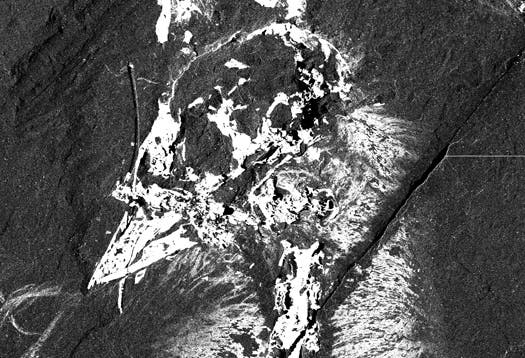Using a new X-raying technique and device, based on synchrotron radiation, scientists have been able to map the pigmentation of creatures dead for million of years just by reading the traces metals in fossils left.
“Every once in a while we are lucky enough to discover something new, something that nobody has ever seen before,” says Roy Wogelius, a geochemist at the University of Manchester and the paper’s lead author.

University of Manchester scientists used this technique to study the Confuciusornis sanctus, a highly primitive bird which lived 120 million years ago and provides one of many evolutionary links between dinosaurs and birds. Harnessing the power of synchrotron radiation, the researchers were able to identify copper-bearing molecules in the fossilized feathers of this ancient bird.
“There is an intimate relationship between trace metals and organics. When you’re getting a good suntan, melanin forms in your skin. There are many forms of melanin, and some are found in the dark feathers of birds, but copper is always bound into its structure,” says Philip Manning, adjunct professor at the University of Pennsylvania.
“You can see this in living animals, but it’s only since we’ve been using a synchrotron—a vast accelerator that generates intense X-rays a hundred million times brighter than the sun—that we can see the chemical detail in fossils and show that the copper complexes we found were originally part of the animal.”
Metallic combounds can survive and consequentely get traced from fossils hundreds of millions of years old. However when these are bound to organic compunds, such as mellanine in skin, a distinction between the two must be made, and this can only be done using such a synchrotron accelerator. Using this device, scientists only had to measure the energy released by the atoms bombard with the high-powered X-radiation, and map out the metal molecules.
“We’re able to map absolute quantities, to parts-per-million levels in discrete biological structures, which we compare with living organisms and see they are comparable,” Manning says.
Painting a richer picture of the lives of ancient creatures
“While our work doesn’t yet allow you to diagnose color, you can get the concentration and distribution of pigments,” Dodson says. “In other words, you can work out monochrome patterns, which may tell us something about camouflage or other traits relevant to natural selection of the species.”
“If we could eventually give colors to long extinct species, that in itself would be fantastic,” says co-author Uwe Bergmann of Stanford University.
“But synchrotron radiation has revolutionized science in many fields, most notably in molecular biology. It is very exciting to see that it is now starting to have an impact in paleontology, in a way that may have important implications in many other disciplines.”
The study holds a particular impact in the event that researchers manage to someday “draw” an accurate image of living organism from hundreds of millions of years ago. Further research with this technique is expected to fully diagnose color via fossil chemistry in the future, so we can only keep our fingers crossed.
Support for the research was provided in part by the United Kingdom’s National Environmental Research Council.
Was this helpful?



